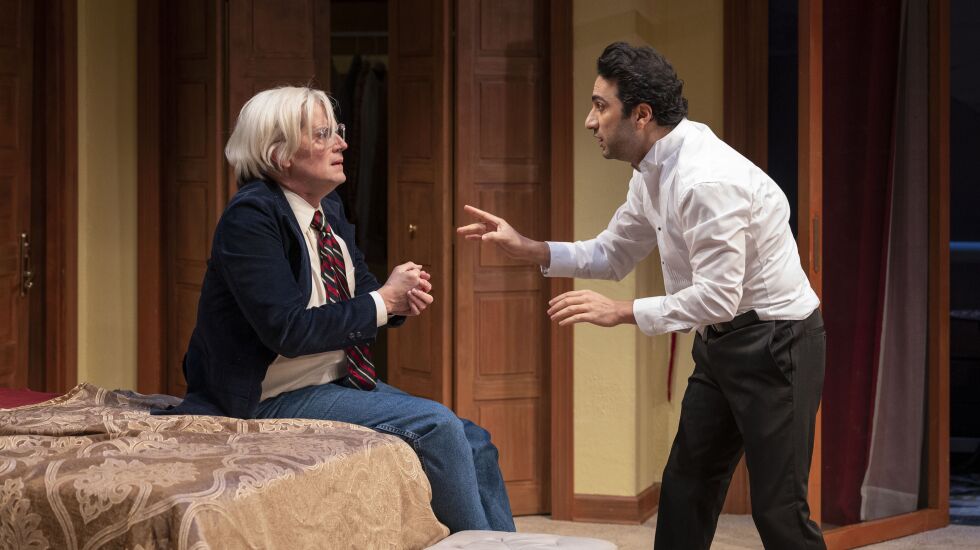
Brent Askari’s momentous drama “Andy Warhol in Iran” is set in Tehran, 1976. But there’s a stunning moment in the drama running through Feb. 19 at Skokie’s Northlight Theatre, when a portrait of Mahsa Amini — the 22-year-old Kurdish woman whose death last year in the custody of Iran’s “morality police” sparked the global Women Life Freedom movement — fills the projection screens mounted above the stage. Far from removing the audience from the world of Iran 47 years ago, Amini’s image underscores the play’s incisive, captivating exploration of Iranian history and how it’s been indelibly shaped by the world’s Western superpowers, namely the U.S. and Britain.
Directed by Northlight Artistic Director BJ Jones, “Andy Warhol in Iran” transpires in a hotel room at the Royal Tehran Hilton but defies containment within those walls with a story that crosses continents and encompasses generations.
The piece is a two-hander that’s cinematic in scope, Askari’s dialogue amplified by the powerful use of projections (by Mike Tutaj). Warhol’s eye-popping art and fabled NYC stable of scenesters loom large. So do images and footage from the 1953 coup (backed by the U.S. and Great Britain) that toppled Iran’s democratically elected prime minister, the 1979 Iranian Revolution and the protests that have been roiling Iran since Amini’s death a little over four months ago.
The plot spins on a fictional meeting between pop superstar Warhol (Rob Lindley) and Farhad (Hamid Dehghani), an Iranian revolutionary. Although the meeting never happened, Warhol did go to Iran in 1976. The artist-filmmaker-provocateur — he of the tomato soup cans and the Marilyn portraits and the underground movies — was a guest of Shah Reza Pahlavi and the Empress Farah Pahlavi, invited to Tehran to take Polaroids of the empress in order to create her portrait.
We don’t meet the shah or the empress in Askari’s two-hander. Instead, Warhol finds himself trapped in his room with Farhad, who says he’s with a group “aligned against the shah.” By kidnapping the most famous artist in the world, Farhad explains, his group will gain the publicity they desperately need to wake the world up to the shah’s regime of torture and oppression and the West’s integral role in putting the shah in power and keeping him there.
Throughout the breathless one-act production (paced like a freight train in Jones’ astute direction), the action parses out impeccably timed revelations about Farhad and Warhol. It might sound like a stretch to find common ground between a rich, white celebrity artist and an Iranian revolutionary, but Askari makes it credible.
In their vastly different worlds, both Andy and Farhad are lifelong, passionate disrupters and both bear both the psychic and physical scars of horrific violence. Warhol repeatedly insists throughout he’s a deeply superficial individual. He natters on about caviar, and “glamorous” parties he loves to attend and the money he loves to make. But as with Farhad, Askari gradually reveals the turbulent depths beneath Warhol’s carefully curated persona. There might be only two characters in Askari’s drama, but they contain multitudes.
From his entrance wheeling a room-service tray, Dehghani creates a character you can’t look away from. It’s not just the bone-authenticity that radiates out whether Farhad is bullying Andy into submission or breaking down in tears at the losses in his own life. There’s a rare, ineffable alchemy when acting prowess and charisma merge into something unforgettable. That’s what Dehghani brings to the stage.
Lindley’s work is just as mesmerizing. His Warhol is understated, intricate and droll, although this is no celebrity impression. Warhol was ever a cypher, but Lindley makes the mystery both relatable and — even at the character’s most vacuous — empathetic.
Todd Rosenthal’s set efficiently captures high-end hotel luxe circa 1970s. But we’re not limited to that world: As Farhad and Andy recall the seminal events that shaped their lives, lighting designer Heather Gilbert sound designers Forrest Gregor and Andre Pluess infuse their respective histories with a surreal universality. We’re in the hotel room, but the story cannot be contained within its walls. Never is that clearer than toward the end of the piece, when Andy breaks the fourth wall to engage with the audience. “So … did any of this even actually happen?” he asks. Farhad responds: “It’s happening Here … Now.”
In the end, “Andy Warhol in Tehran” will resonate for anyone who cares about history. Or the present. Or the future.







